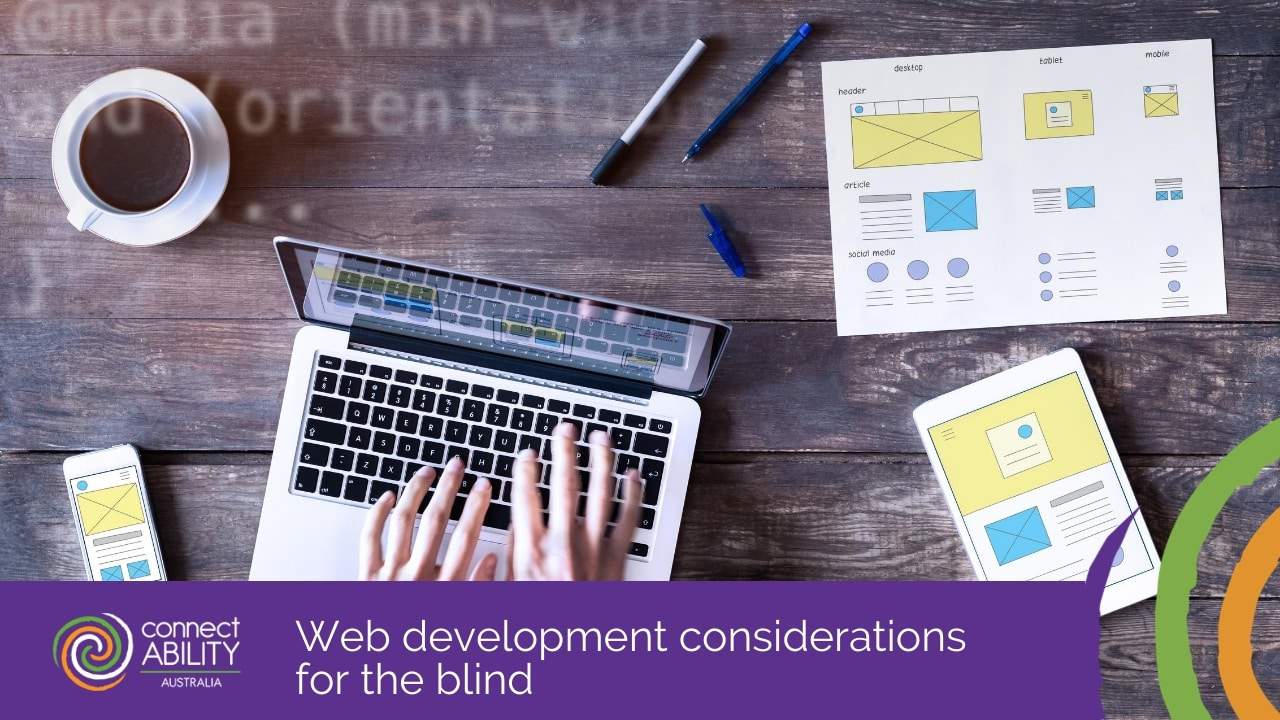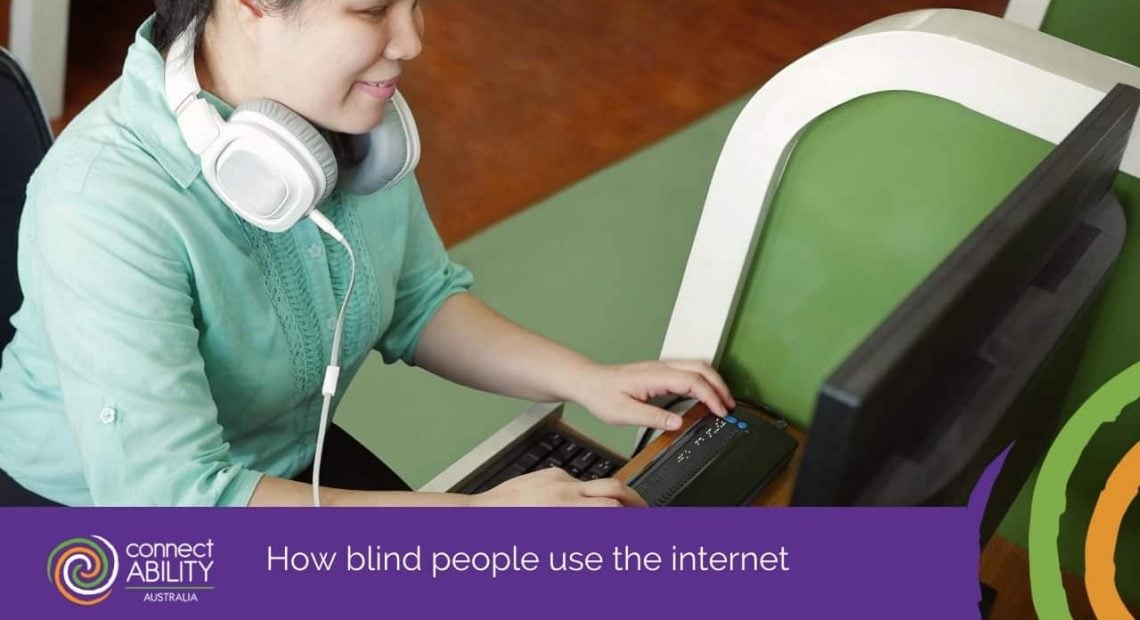The assistive technology, software and thoughtful website development that helps blind and visually impaired people use the internet
Most people will never need to consider how a blind or visually impaired person might navigate the internet. In fact, most of us will never even think to ask the question, and that can lead to the development of technology and content that isn’t necessary accessible to all. Even the visually able have their own blind spots, and the lack of input into web design and technology by our differently abled community members mean that we aren’t creating products that are operating to their maximum potential.
Aside from being motivated by inclusivity and compassion, developing great technology and making websites user-friendly for the visually impaired leads to an increase in something all business owners’ love – more sales! It doesn’t matter who you are, or what your unique limitations are; everyone is a consumer on some level. Increasing access to your product and reducing the friction felt through the buying experience is an absolute must for everyone, not just for those of us without any noticeable disability.
Luckily there are some great companies out there leading the way when it comes to making fantastic assistive technology, and putting the work in to create web-browsing experiences that are inclusive and helpful to all. Every industry that has a website or a product to sell – and that’s almost everyone – should be investing in making their offerings as accessible as possible, and compatible with assistive devices.

What does ‘blind’ mean?
Many will argue that ‘blind’ is a spectrum that describes a sliding scale between normal sight and a complete lack of any sight. In between these two poles sit many different levels and types of visual impairment. These could be in relation how much light is able to be perceived, sharpness of objects and shapes, field of vision and colour spectrum perceived. The traditional definition of blind as per the Oxford Dictionary is “the state of being unable to see due to injury, disease or genetic condition.” Additionally, the Collins Dictionary defines visual impairment as “having any defect of vision, whether disabling or not”.
As one can deduce, there is a very real difference between total lack of vision, and an impairment to normal vision. However, the technologies and design used to assist those inside the vast spectrum of vision impairment and blindness is one and the same, though users may favour certain types of products and software over others depending on their unique sight needs.

Assistive technology and software for the blind and visually impaired
When it comes to using the internet as a blind or visually impaired people, having the right technology to help you along the way is critical. These types of technology are incredibly important to helping blind people live normal and functional lives, and the need is ever increasing as our society puts more and more of our daily lives into internet-based services. The quality of life gap between blind internet users who are comfortable with available technology, and those who aren’t is certainly starting to be felt. As we age many of us become a little less comfortable with learning new technology, and the visually impaired are no exception. Thankfully there are some great resources available to get access to and learn how to use assistive technology that will open up the internet world that most us take for granted on a daily basis.
Screen readers
Screen readers broke the whole internet world open for visually disabled people. Prior to this, it was far harder for them to navigate the internet. A screen reader is software that allows visually impaired or blind people to read websites by ‘scanning’ the content of a web page and reading it aloud to the person. Often the speech speed is far greater than what a sighted person could understand, as blind and visually impaired people learn to listen at far greater speeds than normally sighted people.
The user is able to navigate through the main headings and topics to find what they’re looking for in exactly the same way as people with normal vision scan a website with their eyes to find the content they’re looking for. Screen readers aren’t just limited to reading out content, they also help the user navigate through different controls and functions on the website as well. This software can be installed on normal laptops, tablets and other e-readers.
There are two main developers and facilitators of this software: Jaws (Job Access With Speech) and Nvda (Non Visual Desktop Access). According to articles written by the blind for their own community, neither is better than the other – it comes down to personal choice, and sometimes the systems perform better depending on the device it is being installed on.
Braille Keyboards
Blind and visually impaired users can use normal keyboards, provided that they have Braille impressions on the keys and they understand how to read Braille. Braille is a language developed for the blind to enable them to read, where the alphabet is represented by formations of raised dots meant to felt by the fingertips. Essentially, Braille is a sensory alphabet. While standard keyboards are often still preferred by blind users for input, special Braille readers can be attached to them to interpret the content being browsed, and send output to the user by raising and lowering the Braille symbols at reading pace. Where screen readers read the content aloud, Braille readers deliver the content in reading form.
However, there are some specially designed keyboards for blind and visually impaired people that are more ergonomically set up to maximise the use of both a screen reader and Braille reader simultaneously. Some even include a touch screen option like those made by the company Humanware.

Web development considerations for the blind
While having great tools and technology helps, much of the battle happens when a website isn’t built in an accessible or inclusive way. This isn’t a new concept – it’s taken us all many years to provide physically accessible buildings, travel options, education and learning facilities and technology innovation to make our society more inclusive for all people with a disability. This has only come about by authentic engagement and collaboration with our disabled community members, and we arguably still have a long way to go.
The amazing this is that the more user friendly we make internet access for the blind and for all disabled people, the more likely it is that they can secure the type of careers they could have to improve things for their specialised communities from the inside out. No one is better qualified to design technology and user experience for the blind, than blind web developers and innovators themselves. By supporting people in our disabled community, we can equip them with the tools and knowledge to create products that far outstrip what any normally abled person could create for them – they are uniquely placed to know their needs far better than we.
UX Design
The process of UX (User Experience) Design refers to designing an experience for a user on a website that is useful, meaningful and relevant. How a user visiting your websites finds the experience can have a huge impact on how likely you are to make a sale or have an article read. The UX design process aims to create a website that is logically laid out and easily navigable, with convenient features that are relevant to the site – things such as Wish list functions, enquiry forms, easy linking to social media, user reviews, and any other function that improves the functionality or delights a user. It could also include pleasing colours, animations and sound effects.
Different businesses and products will have very different UX considerations – very few people will use the Wish list function on a butcher website, but they might like the option to log in and repeat a previous order. For fashion and home wares companies, a Wish list function is a must have – repeat orders would be far less applicable. It goes without saying that if you’re a website that provides information to the blind or visually impaired that you would have accessibility functions that support that, like ‘article to audio’ functions and colour/contrast adjusters.
Considering the needs of blind and visually impaired people in the UX Design process greatly increases their ability to navigate and enjoy a website. There are many accessibility options that could be considered during the design process that can be used to make an inclusive website at very little extra effort – in fact plenty of normally sighted people often enjoy using the accessibility functions of websites when they’re offered. These include things like ‘dark mode’ and ‘high contrast’ and adjustable font size viewing options.
Alt Tags
Also known as ‘alt attributes’ or ‘alt descriptions’, these are the text-based descriptions assigned to an image uploaded on a website. Screen readers and Braille keyboards are not able to ‘read’ and image, and so rely on web developers to input a relevant and helpful description on the image so that blind users are able to ‘see’ the images – or at least get an idea of what it is they’re scrolling past. While many view Alt Tags as only important for SEO (Search Engine Optimisation) purposes, these tags are extremely vital for the blind community. If an image is only there for decoration purposes, and not to convey a specific message, this is the only exception to alt text being important. Otherwise – describe, describe, describe!

Thoughtful content structuring
Regardless of whether you’re normally sighted, visually impaired or completely blind – we all have something common. We usually prefer to digest information in an orderly, logical and easy-to-digest way. Part of that if how text-based content is structured, as well as how it is laid out on a web page. For those with perfect vision, a huge dump of text with no headings or images is navigable – but far from enjoyable. For those relying on screen readers or braille keyboards – it’s a real nightmare!
Screen readers and braille keyboards rely on the creators of content to structure things thoughtfully. This means things like clear headings and subheadings, and alt text on images. It also means that websites should minimise the amount of interruption to their on-page content by avoiding putting paid advertisements, pop-ups or sale banners throughout text based content. These are best left to the sides or bottom of pages to improve the flow of reading for all users, but they can be especially confusing for screen readers and Braille keyboards to interpret.

Lifting up our blind and visually impaired community
At ConnectAbility, this issue is close to our hearts. We care for and provide support to many blind or visually impaired clients and we know how life changing these technologies – and sometimes very small considerations – can be for them. It may only take the smallest amount of effort on the part of wed developers, UX designers, technology innovators and resource educators to create an inclusive global society through our internet. This will in turn allow people to lift themselves up, and pursue careers, hobbies and passions that may have never been possible before. For such a small contribution, the reward is immense. From a business perspective, having an accessible and user friendly website for blind and vision impaired people will only serve you in the long run – just like any normal human, people give recommendations when they have great experience.
If you would like more information on how to access assistive technology or learn how to use it on the internet, the expert team at ConnectAbility can help. We can provide access to information, resources and support to get you or your loved one back on track and browsing the web with the best of them! Call us or send in an enquiry today to find out more.


